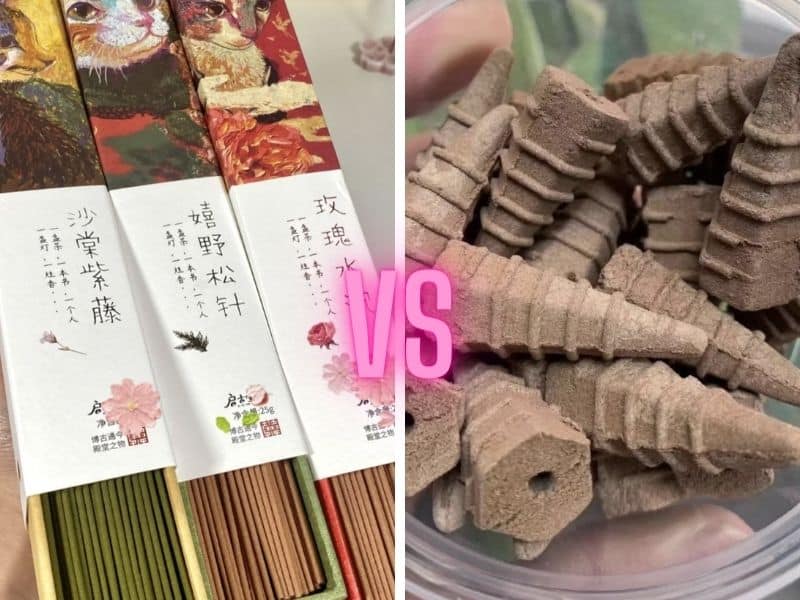With so many different types of incense that exist, you might struggle to figure out which one is most beneficial. You should consider how you plan to use the incense in order to choose the best one.
I’ll outline the differences between two of the most common types of incense in this article.

Incense Sticks vs Incense Cones
Generally speaking, incense sticks and cones serve the same purpose: to release aromatic fragrance into the air.
But there are slight differences between the two that influence how each incense type carries out this purpose and varies their usage.
How Are Incense Sticks Made?
There are two main ways that incense sticks are made. They either have a support base, usually made of bamboo wood, or they are pressed out into stick form without the wooden core.
More specifically, barks, herbs, resins, and more plant matter are all ground into powder form. Essential oils and sometimes fragrance oils are added. A binder (usually natural botanical gum) moistens this powder, creating a paste. The paste is then pressed around the bamboo core, usually by hand, leaving a portion of the wood at the end to help with burning the incense.
The second form of stick incense uses a similar process, except instead of pressing the paste around wood, the ingredients are extruded out of a machine that looks similar to a pasta maker. Once the sticks are formed, they are left to dry.
Since there isn’t a wooden core with the second method, these sticks are more delicate and can break more easily. This can be beneficial, though. I like breaking my extruded sticks in half when I want to shorten their burn time. I can’t do this with incense that has a wooden core.
If you want to reduce the burn time for incense with a support base, you would have to dip it into water or place it under running water to extinguish it.
How Are Incense Cones Made?
Similar to the method above, incense cones are compressed botanical matter with added essential or fragrance oils. They are molded into cones instead of sticks.
Usually their fragrance is more concentrated and can linger in the room for a longer period of time because they’re so densely packed and so much fragrance is burned at once.
How Long Do Incense Sticks Burn vs Incense Cones?
Typically incense sticks burn longer than incense cones. For example, shorter incense sticks can burn for the same amount of time as an incense cone. But this can vary widely between and within brands.
Wild Berry incense is the best illustration of this. They offer sticks in various lengths, and they sell both regular and backflow incense cones.
Wild Berry Incense Sticks Burn Time
| Type | Length | Burn Time |
| Shorties | 4-inches | 30 mins |
| Traditionals | 11-inches | 60 mins |
| Biggies | 19-inches | 180 mins |
Wild Berry Incense Cones Burn Time
| Type | Height | Burn Time |
| Traditional | 1-inch | 30 mins |
| Backflow | 2-inches | 30 mins |
As you can see, Wild Berry Shorties are three inches longer than their traditional incense cones and two inches longer than their backflow incense cones, but all three have the same burn time of half an hour. Essentially, even short incense sticks burn longer than the cones because at twice as long, they finish burning at the same time.
Shoyeido incense cones (more than 1 inch tall) burn for 10 minutes, but the burn time for their sticks varies because some are longer than others. Some are as short as 2.75 inches and burn for 15 minutes.
Even in this case, their shortest stick is not much longer than their cones, but it still burns a full five minutes longer.
My favorite Shoyeido fragrance, Moss Garden, comes in a box of 35 sticks, each one 8.75 inches long. They burn for 50 minutes. But this is an example of variance within brand and even within fragrance because the same scent is offered in a set of 500 sticks. Each stick is only 5.25 inches long and burn for 30 minutes.
Moss Garden isn’t offered in cone form.
Do Incense Sticks and Cones Offer The Same Fragrances?
I have found that incense cones are not typically offered in as many scents as incense sticks. Of course, this also varies by brand. But the most incense brands tend to offer a limited fragrance selection for their incense cones.
One exception is HEM. I think they might offer an incense cone fragrance for all of their scent offerings, which is an extensive list, but typical of their brand.
More traditional companies offer significantly fewer scents in cone form. For example, Shoyeido only sells incense cones for their Floral World collection, which is only four fragrances: pine, lavender, rose, and jasmine.
Comparatively, Nippon Kodo offers 17 incense cone options in fifteen scents. But they have 164 regular 5-inch stick incense fragrances, 60 short stick options; and 25 long stick scent options. Pretty wide differentials.
On their website, Gonesh incense cones are available in only six of their more popular scents:
- No. 10
- No. 2
- No. 14
- Cherry blossom
- Cinnamon
- Raspberry
On Amazon, you can find about a dozen Gonesh incense cone scents, but based on those images, some of them appear to be stockpiles from third parties, not listings directly from Gonesh. This leads me to believe that they are only producing the incense cone scents available on their website, but I can’t say for certain.
Lastly, Wild Berry incense cone fragrances are also only a fraction of all the scents they sell, I counted 24 regular incense cone fragrance options and only half as many backflow incense cones.
In any case, it is obvious that incense cones are not available in as many fragrance options as incense sticks. I haven’t found a concrete reason for this. It’s possible that they’re simply less popular, but I’m not sure. If you know the reason, feel free to mention it in the comments section below.
Lower quality incense cones tend to be available in a variety of scents, but they also tend to have a strong perfume or chemical-like smells.
Burning Equipment for Incense Sticks vs Cones
Another difference between incense sticks and cones is the way you burn them. If you want to know my favorite picks, read this article about the best incense burners and holders.
For safety reasons, incense sticks must be held in place as they burn. Some burners are upright, others are angled. But either way, there must be a fireproof holder underneath the incense stick to catch its ashes.
If they aren’t positioned properly, though, ashes from incense sticks can still fall on the surface beneath its holder. Cleaning up after an incense stick has burned can sometimes get messy.
Regular incense cones on the other hand burn into a little heap of ashes. They can be placed in cone holders, of course, but you have more leeway with cones.
You can burn incense cones on an old ceramic dish or plate that you’re no longer using. Glass or metal cups, plates, or other dishes would also work well. Once they’ve fully burned, you can simply toss the ashes in the bin. Easy clean up.
Backflow incense cones burn in a nest little heap as well but require a special burner. Here are details about my favorite backflow incense burners. In short, though, in order for you to fully experience the cloud of smoke from this type of incense, you must have a burner that carries the smoke downwards.
What Causes Incense Sticks to Stand Out?
Incense sticks come in a much wider range of fragrances, in most scenarios. You also have options in terms of there being a central wooden core.
More smoke fills the room when burning incense with a wooden core. The amount of smoke also depends on the ingredients added to your incense paste. If a company uses a lot of additives and artificial ingredients, there will be an abundance of smoke.
Brands like Gonesh use a high charcoal formula that releases more smoke than Japanese brands, but less smoke than Indian brands. If you’ve ever burned these three types of incense, you’ll definitely notice the difference.
This is why extruded incense sticks are typically labeled, “low smoke.” There’s no wood burning with the other incense ingredients and they use all natural components.
Incense sticks also come in a variety of lengths and widths, expanding the options available for this format.
When burning, it only takes a few seconds to light the incense stick, have it glow, and then blow out the flame. Incense cones take longer to get started – at least 10-15 seconds.
What Makes Incense Cones Special?
Smoke from incense cones can flow upwards or downwards. Regular incense cones burn upwards, similar to incense sticks. Backflow incense cones, on the other hand, are the opposite.
Backflow cones have a small hole burrowed through their base, designed to generate smoke that flows down its burner, creating visually soothing effects.
Incense cones are packed with natural ingredients, in most cases. Wild Berry and Gonesh incense cones are charcoal-based. And honestly, I would not even consider burning any kind of incense from brands less expensive than these two companies.
That leaves us with higher quality cones, like Shoyeido, Nippon Kodo, and Jembrana. Ingredients include natural materials and essential oils, which burn cleanly, letting off wafts of concentrated aroma without the smell of wood, since there’s no bamboo core.
In short, with traditional cones, you’re experiencing intense fragrance in a short time frame. With backflow incense cones, you will smell wonderful aroma, but there’s more emphasis on the pillowy clouds of smoke that creep down the burner.
Final Thoughts
Burning incense can be a soothing experience and it can even be used as a timer during meditation or yoga practice. Some people burn incense solely for the aroma and others like to burn backflow cones for the meditative visual experience.
Determining whether incense sticks or cones are better largely depends on how you want to use them.
Use incense sticks if:
- You don’t mind possibly smelling wood or charcoal
- You prefer longer burn time
- You desire a wider selection of fragrances
- You don’t mind using incense burners
Use traditional incense cones if:
- You like concentrated fragrances
- You prefer shorter burn time
- You don’t mind limited fragrance availability
- You prefer not to buy additional accessories
Use backflow incense cones if:
- You want a visual experience
- You prefer shorter burn time
- You don’t mind paying a little more
- You don’t mind buying specialized accessories
Both incense sticks and cones can be beneficial at different times. Which do you prefer?
